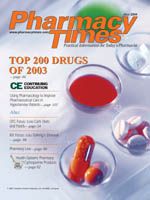Publication
Article
Pharmacy Times
"Fax Noise" Can Result in Medication Errors
Problem
Most health care practitioners would agree that facsimile (fax) machineshave facilitated communication of prescriptions. There are, however, inherentproblems associated with this technology. In fact, a recent article in theJournal of Managed Care Pharmacy found that prescriptions received byfax required a greater number of clarification calls than those received byother methods of communication.1
We received a report from a longterm care facility about a patient whohad been receiving Neurontin (gabapentin) 600 mg tid. An order had beenfaxed to the pharmacy that the pharmacist thought read to change theNeurontin dose to "300 mg 1 tab qid." The change was made, and thenew dose was sent to the facility.
Later, when the pharmacist received the original order and compared itwith the faxed order, he realized that the physician had actually requested achange to "800 mg 1 tab qid." The left side of the order had been cut off duringthe fax transmission, making the "8" look like a "3." Fortunately, becausethe pharmacist had been sent the original order for comparison, hequickly realized the mistake. Unfortunately, not all outpatient pharmaciesreceive the original prescription for comparison.
In another report, a faxed prescription was received at a pharmacy forwhat appeared to be for Monopril (fosinopril) "10 mg #90 one tablet daily."Despite the fact that the fax machine created a definite vertical streak thatran between the drug name and the strength, the pharmacist felt confidentin her interpretation of the prescription. Unfortunately, the prescriptionwas actually for "40 mg." The streak had run through the "4" in "40 mg,"making it look like "10 mg" instead.
A prescription (see Figure) was faxed to a mail-order pharmacy. Look at thebottom order for "Lisinopril/hctz." (Note: ISMP does not condone the useof the abbreviation "hctz.") The pharmacist interpreted this order as "20/25mg." What the prescriber had actually written, however, was "20/12.5 mg."A subtle vertical gap in the faxed copy (which also can be seen "breaking" thecircles around "3 months supply") had obliterated the "1" in "12.5." In addition,the pharmacist reading the order had misinterpreted the decimal pointas one of many stray marks.
Safe Practice Recommendations
"Fax noise" (the random marks andstreaks on faxes) is an inherent problem with this technology, and it maybe more common with old or poorly maintained fax machines. Usually, faxnoise is just an inconvenience. In the case of prescriptions, however, there isa very real chance that a patient could be harmed by misinterpretationcaused by fax noise. To manage this risk, the pharmacist should instill safeguardsfor the fax process. Such safeguards include the following:
- Carefully review faxed orders for fax noise. If the transmission has fax noise in the area of the order, call the prescriber to confirm the prescription.
- Check the faxed order against the original, if it is available. Prescribers should consider giving a copy of the prescription to the patient to present at the pharmacy for verification. To prevent confusion or duplication of the prescription at a different pharmacy, the copy could be stamped with a statement such as "Verification Copy ONLY" to indicate that the prescription already was faxed to a particular pharmacy.
- Schedule regular maintenance of fax machines on both the sending and receivingends. If maintenance fails to improve fax quality, the machine should be replaced.
Drs. Kelly and Vaida are both with the Institute for Safe Medication Practices (ISMP). Dr.Kelly is the editor of ISMP Medication Safety Alert! Community/Ambulatory Care Edition,and Dr. Vaida is the executive director of ISMP.
For a list of references, send a stamped, self-addressed envelope to:References Department, Attn. A. Stahl, Pharmacy Times, 241 Forsgate Drive, Jamesburg, NJ 08831; or send an e-mail request to: [email protected].
Report Medication Errors
The reports described here were received through the USP Medication Errors ReportingProgram, which is presented in cooperation with the Institute for Safe Medication Practices (ISMP).ISMP is a nonprofit organization whose mission is to understand the causes of medication errors andto provide time-critical error-reduction strategies to the health care community, policy makers, andthe public. Throughout this series, the underlying system causes of medication errors will be presentedto help readers identify system changes that can strengthen the safety of their operation.
If you have encountered medication errors and would like to report them, you may call ISMP at800-324-5723 (800-FAILSAFE) or USP at 800-233-7767 (800-23-ERROR). ISMP's Web addressis www.ismp.org.
Subscribe to Newsletter
Pharmacy Times and the Institute for Safe Medication Practices (ISMP) would like to makecommunity pharmacy practitioners aware of a publication that is available.
The ISMP Medication Safety Alert! Community/ Ambulatory Care Edition is a monthly compilationof medication-related incidents, error-prevention recommendations, news, and editorialcontent designed to inform and alert community pharmacy practitioners to potentially hazardoussituations that may affect patient safety. Individual subscription prices are $45 per year for 12monthly issues. Discounts are available for organizations with multiple pharmacy sites. This newsletteris delivered electronically. For more information, contact ISMP at 215-947-7797, or send ane-mail message to [email protected].

Newsletter
Stay informed on drug updates, treatment guidelines, and pharmacy practice trends—subscribe to Pharmacy Times for weekly clinical insights.






